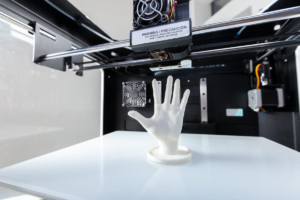Three different federal agencies came together to leverage and speed up 3D printed PPE and other advanced manufacturing technologies in the fight against the novel coronavirus. The FDA, the VAD, and the NIH signed a Memorandum of Understanding to formalize a combined effort through which they’ll solicit designs for, produce and test 3D-printed safety supplies to support America’s response to the worldwide health emergency.
Through working together, the three agencies are also engaging in a public-private partnership with the non-profit accelerator America Makes, which will act as a sort of matchmaker between the healthcare facilities that need the agency’s approved products, printing and manufacturing industry experts with the capacity to produce them.
The FDA regulates devices made with 3D printing technology in the same way it regulates devices made using other manufacturing processes. In 2016, the FDA issued draft guidance on Technical Considerations for Additive Manufactured Devices to clarify device design, manufacturing, and testing considerations for device manufacturers using 3D printing.
More recently, when it was exposed that using 3D printers could help address the shortage of protective equipment, the FDA jumped to recommend healthcare professionals to take additional precautions when using these products that have not undergone FDA premarket review.
In order to guarantee the security and safety of 3D printed PPE, FDA guidelines should be expanded to guard against cyberattacks during the design of PPE, when printing is underway and after printing has ended, according to the engineers’ white paper site. But the most recent FDA guidelines fail to defend the process against cyberattacks, the same site revealed.

“Typically, the designer generates PPE design files and shares them on a cloud service, and the 3D printing operator downloads and starts the manufacturing process,” said Saman Aliari Zonouz, an associate professor in the Department of Electrical and Computer Engineering in the School of Engineering at Rutgers University. “Potentially, a malicious designer could generate a malicious design file and start the printing process himself before distributing 3D printed objects to users,” he then added.
For example, a rogue operator could design a 3D-printed mask with a malicious embedded part that connects an air filter to the mask. After printing the mask, a cyberattack could change the part’s structure to let air bypass the air filter. Cyberattack detection tools such as artificial intelligence could be implemented to detect and thwart such attacks.
We are working hard to create a safe environment for everyone.
While the country finds ways to solve PPE’s shortage, at We Shield, we create a safe and clean environment for our front line workers and individuals. Especially for those at most risk of contracting COVID-19 by sourcing and distributing top-quality personal protective equipment and safety supplies at the best pricing on the market.
